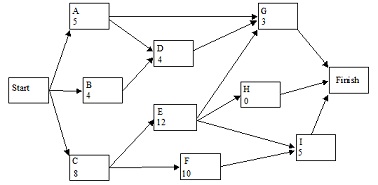Complete the mcq:
1. Arcs in a project network indicate
a. completion times.
b. precedence relationships.
c. activities.
d. the critical path.
2. The critical path
a. is any path that goes from the starting node to the completion node.
b. is a combination of all paths.
c. is the shortest path.
d. is the longest path.
3. Activities following a node
a. can begin as soon as any activity preceding the node has been completed.
b. have an earliest start time equal to the largest of the earliest finish times for all activities entering the node.
c. have a latest start time equal to the largest of the earliest finish times for all activities entering the node.
d. None of the alternatives is correct.
4. Slack equals
a. LF - EF.
b. EF - LF.
c. EF - LS.
d. LF - ES.
5. Activities with zero slack
a. can be delayed.
b. must be completed first.
c. lie on a critical path.
d. have no predecessors.
6. Which of the following is always true about a critical activity:
a. LS = EF.
b. LF = LS.
c. ES = LS.
d. EF = ES.
1. Critical activities are those that can be delayed without delaying the entire project.
2. PERT and CPM are applicable only when there is no dependence among activities.
3. A path through a project network must reach every node.
4. A critical activity can be part of a noncritical path.
5. The earliest finish time for the final activity is the project duration.
A project network is shown below. Use a forward and a backward pass to determine the critical path, and then fill out the table below.
|
Activity
|
Precedence Activities
|
Activity
Time (weeks)
|
ES
|
LS
|
EF
|
LF
|
Slack
|
|
A
|
|
|
|
|
|
|
|
|
B
|
|
|
|
|
|
|
|
|
C
|
|
|
|
|
|
|
|
|
D
|
|
|
|
|
|
|
|
|
E
|
|
|
|
|
|
|
|
|
F
|
|
|
|
|
|
|
|
|
G
|
|
|
|
|
|
|
|
|
H
|
|
|
|
|
|
|
|
|
I
|
|
|
|
|
|
|
|
|
Finish
|
|
--
|
--
|
--
|
|
--
|
--
|
